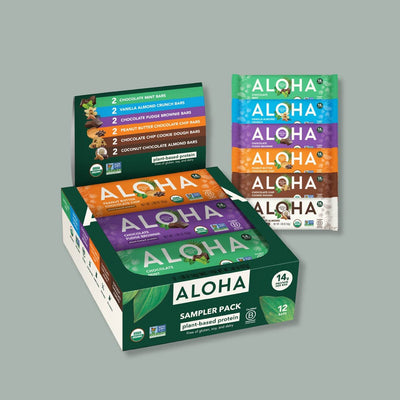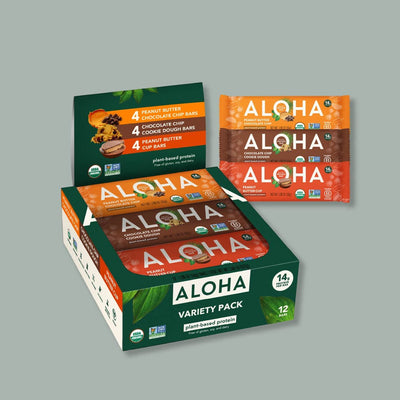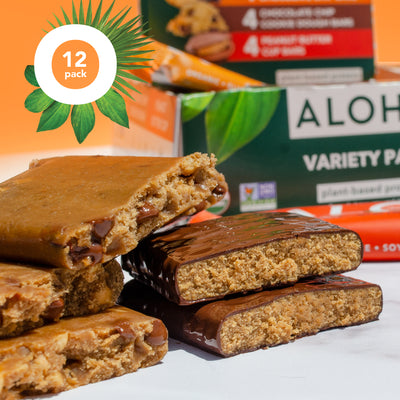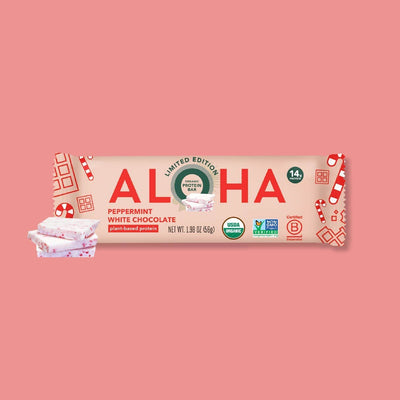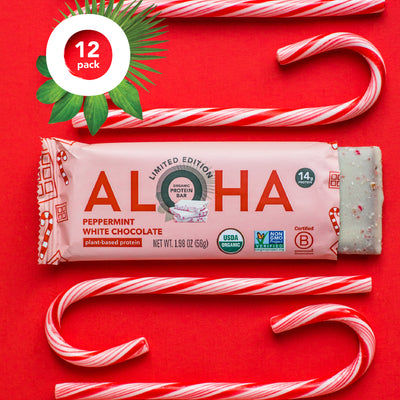Key Takeaways:
- Always Read the Label: Many white chocolate products contain hidden dairy ingredients, making it crucial to scan for terms like “milk solids,” “whey,” or “casein.”
- Vegan Can Still Taste Great: High-quality vegan white chocolate alternatives use simple, clean ingredients for the same creamy, satisfying experience.
- It’s About More Than Ingredients: Opting for vegan white chocolate isn’t just about food — it often supports animal welfare, sustainability, and ingredient transparency.
Is white chocolate as plant-based friendly as it looks? With its smooth texture and creamy sweetness, it’s easy to assume it fits into a vegan lifestyle — but the truth is a bit more complicated.
At ALOHA, we’re not here to play guessing games with ingredients. As a Certified B Corp and Climate Neutral company, we take pride in creating plant-based, organic, and non-GMO products that stay true to your values. Every item we make is thoughtfully crafted, using ingredients you can recognize and trust.
In this piece, we’ll unpack what goes into white chocolate, why it’s typically not vegan, and how to make better choices without giving up on taste.
Why Most White Chocolate Isn’t Vegan
The biggest reason white chocolate typically doesn’t qualify as vegan comes down to one key ingredient: milk.
Unlike dark chocolate, which can sometimes be made without dairy, traditional white chocolate always includes milk solids or milk powder. These give white chocolate a creamy consistency and rich mouthfeel, making it an animal-derived product.
Even products labeled as “dairy-free” or “non-dairy” can be misleading. Some still contain casein, whey, or other milk derivatives that don’t meet vegan standards. That’s why checking labels closely is important if you’re committed to avoiding animal-based ingredients.
So, is white chocolate vegan? Most of the time — no. But the good news is that alternatives made without dairy still deliver the smooth sweetness you expect.
Are There Vegan Alternatives To White Chocolate?
Yes — and they’re becoming easier to find. While traditional white chocolate relies on dairy, vegan versions swap those ingredients for plant-based alternatives without compromising taste or texture.
Instead of milk solids, vegan white chocolate often uses coconut milk powder, rice milk, or almond milk powder. These ingredients help create that familiar creaminess without using animal products. The base still includes cocoa butter, which is naturally plant-based, but the rest is carefully reformulated to align with vegan values.
The result? A treat that looks and tastes like white chocolate but fits into a plant-based lifestyle. More brands are embracing this dairy-free take, from baking chips to snack bars, especially as the demand for ethical and transparent products grows.
How To Spot Vegan White Chocolate On Labels
Shopping for white chocolate as a vegan can feel a bit like detective work. Not all ingredients are as straightforward as they seem, and dairy tends to hide in plain sight. To help you make confident choices, here’s what to look for when reading product labels:
- Check for Common Dairy Ingredients: Milk is rarely labeled “milk.” Instead, you’ll often see terms like milk solids, milk powder, whey, or casein — dairy-based and not vegan-friendly. Even ingredients with “lact” in the name (like lactose or lactalbumin) signal the presence of dairy. If you spot any of these, the product isn’t vegan.
- Look for Vegan Certifications or Labels: One of the easiest ways to confirm if white chocolate is vegan is to look for third-party labels. Certifications such as “Certified Vegan,” “100% Plant-Based,” or the Vegan Society logo give you immediate peace of mind. These labels show that a product meets strict vegan standards without requiring you to decode the ingredient list.
- Identify Dairy-Free Alternatives: Vegan white chocolate often replaces dairy with plant-based options like coconut milk powder, almond milk, or rice milk. These alternatives mimic milk solids' creamy texture without using animal-derived ingredients. Spotting these on the label is usually a good sign that the product is vegan.
- Watch for Hidden Ingredients: Some products claim to be non-dairy but still contain small amounts of animal byproducts. Terms like natural flavors or emulsifiers can sometimes include animal-derived substances unless specified otherwise. When in doubt, choose products that fully disclose their sourcing or are made by brands known for transparency.
- Trust Brands That Lead With Plant-Based Values: Brands committed to plant-based lifestyles typically make this clear on their packaging. Look for companies that highlight their vegan identity upfront, so there’s less guesswork involved. When transparency is part of the brand’s DNA, it’s easier to trust what’s inside.
Why It Matters: Health, Ethics, And Sustainability
Choosing vegan white chocolate isn’t just about the ingredients — it often reflects a bigger lifestyle choice. For many, it’s tied to values around animal welfare, environmental impact, and transparency in food production. Here’s how these core ideas connect to something as simple as a chocolate bar:
Animal Welfare Is A Driving Factor
Traditional dairy production involves the use of animals, which is a major concern for many people following a vegan lifestyle. Avoiding milk-based ingredients in white chocolate supports the decision to minimize harm to animals. It's a small but meaningful way to align everyday choices with ethical beliefs.
Environmental Impact Is Part Of The Equation
Animal agriculture, including dairy farming, contributes significantly to greenhouse gas emissions and resource consumption. Choosing plant-based alternatives can reduce your food choices environmental footprint. The impact increases over time, even with something small like white chocolate.
Transparency Builds Trust
Brands that offer vegan options tend to be more transparent about their ingredients and sourcing practices. That level of openness makes it easier for shoppers to trust what they’re buying — and who they’re buying it from. It also reflects a growing shift in consumer expectations around honesty and accountability.
What To Look For In Vegan Protein Snacks
Finding a plant-based snack that fits your lifestyle doesn’t have to be complicated. The key is to look beyond marketing buzzwords and focus on what matters: simple ingredients, transparent sourcing, and flavors that feel satisfying. Here’s how to navigate your options when it comes to vegan protein snacks:
- Start with the Ingredient List: A shorter ingredient list often means fewer additives and more whole-food ingredients. Look for snacks with recognizable plant-based sources like nuts, seeds, and oats. These choices support a clean, straightforward approach to snacking.
- Check for Vegan Certification: Like with white chocolate, a certification helps confirm that a product aligns with vegan values. Terms like “Certified Vegan” or “100% Plant-Based” provide quick reassurance without digging too deeply into every component. These labels also show that the brand has gone through third-party verification.
- Prioritize Brands That Are Transparent: It’s not just about what’s in the bar — it’s about who’s making it. Brands that lead with transparency typically list the origin of their ingredients, avoid vague terms, and share their mission openly. That openness often reflects a stronger commitment to values that matter to plant-based consumers.
- Look for Organic and Non-GMO Indicators: For many plant-based consumers, it’s not just about avoiding animal products — it’s also about clean sourcing. Snacks that are organic and non-GMO align with a more mindful approach to food, supporting better agricultural practices. These labels help you trust the quality of what you’re eating.
- Flavor Should Feel Natural, Not Overdone: Vegan snacks should taste good, not overly sweet or artificial. Look for bars that use natural sweeteners like fruit or maple syrup and avoid excessive flavor enhancers. A balanced, enjoyable taste is a sign of quality ingredients coming through, not being covered up.
Why Taste Doesn’t Have To Be Sacrificed
There’s a lingering misconception that choosing plant-based means settling for less, especially when it comes to indulgent flavors like white chocolate. But that couldn’t be further from the truth. When vegan snacks are crafted with care, the result can be just as flavorful, if not more so, than traditional options.
Here’s how thoughtful choices in ingredients, flavor balance, and texture come together to create a fully satisfying experience, without the need for compromise:
Flavor Comes From Quality Ingredients
Good taste starts at the source. Vegan snacks that rely on real cocoa butter, freeze-dried fruits, organic vanilla, and natural sweeteners can achieve depth and richness without artificial extras. It’s not about mimicking something else — it’s about letting clean, purposeful ingredients shine on their own.
Balance Matters More Than Intensity
Great flavor isn’t about overpowering sweetness or over-engineered combinations. It’s about harmony — where elements like bright raspberry and creamy white chocolate-style coating work together, not against each other. That balance makes each bite feel intentional and satisfying, unlike an afterthought.
Texture Plays A Big Role In Enjoyment
Flavor is only half the story — texture is just as important to our food experience. The contrast between a soft, chewy base and a smooth outer layer, or a light crisp from nuts and seeds, can elevate a snack from decent to delicious. When texture is dialed in, the experience becomes more indulgent, even without dairy or traditional fillers.
You Don’t Have To Choose Between Values And Taste
Too often, people feel they must give up their enjoyment and stick with plant-based eating. But snacks that are made intentionally — using simple, high-quality ingredients — prove otherwise. Taste and values can go hand in hand when a product is built with both in mind.
Final Thoughts
At the end of the day, choosing vegan white chocolate is about more than checking ingredients — it’s a reflection of the values you carry into every part of your lifestyle. Whether you're motivated by ethics, sustainability, or simply a desire for clean, plant-based indulgence, the good news is that you don’t have to settle. With more brands embracing intentional, dairy-free formulations, white chocolate can still be part of your snack lineup — delicious, mindful, and 100% aligned with your choices.
Read also:
- Does Protein Make You Feel Full? Benefits Explained
- Complete Vs Incomplete Proteins
- How To Get Protein Without Meat: Top Plant-Based Sources
Frequently Asked Questions About White Chocolate: Is White Chocolate Vegan
Can white chocolate be accidentally vegan?
It’s very unlikely. Most white chocolate recipes rely on milk derivatives, which makes them non-vegan by default. Unless labeled vegan, it's safe to assume it's not.
Why is white chocolate treated differently from dark chocolate in vegan diets?
Dark chocolate often contains fewer ingredients and can be dairy-free by default. White chocolate, on the other hand, typically requires milk solids for its texture and color. That built-in reliance on dairy is what sets them apart in vegan labeling.
Is cocoa butter in white chocolate vegan?
Yes, cocoa butter is plant-derived and comes from the cacao bean. Despite its name, it doesn’t contain dairy. It’s the milk ingredients added to white chocolate that make it non-vegan.
Are there specific countries where white chocolate is more likely to be vegan?
Some countries with stricter food labeling laws, like those in parts of Europe, may offer more clearly labeled vegan white chocolate options. However, vegan versions remain a specialty product globally. Always check the label regardless of origin.
Why do so few major chocolate brands offer vegan white chocolate?
Vegan white chocolate requires reformulating traditional recipes, and many large brands stick with legacy formulations. Also, demand is just rising, pushing only niche or plant-based brands to lead the way. This is gradually changing as consumer awareness grows.
Can you bake with vegan white chocolate like regular white chocolate?
Yes, vegan white chocolate behaves similarly in baking. The melt and consistency might vary slightly depending on the plant-based milk alternative. It’s always a good idea to test small batches when substituting.
Is vegan white chocolate healthier than regular white chocolate?
Not necessarily. While it avoids dairy, it can still contain sugar and fats like its counterpart. “Vegan” doesn’t automatically mean healthier — it just means it’s made without animal products.
What makes vegan white chocolate more expensive?
The ingredients used in vegan products, like coconut or almond milk powders and organic flavorings, tend to cost more. Production is also smaller-scale, especially for specialty brands. All these factors contribute to a higher price point.
Does vegan white chocolate taste the same as regular white chocolate?
It can be very close in flavor and texture, especially with high-quality ingredients. Depending on the formulation, some say it tastes even cleaner or less sweet. The difference is subtle but noticeable to some palates.
Are there vegan snacks with white chocolate flavor that don't use actual white chocolate?
Yes, some plant-based snacks replicate the flavor using dairy-free coatings or blends that mimic the taste. These products give you the white chocolate experience without relying on traditional ingredients. It’s a creative solution when real vegan white chocolate isn’t available.
Sources:
1. Etter, B., Michel, F., & Siegrist, M. (2024). Consumers’ Categorizations of Dairy Products and Plant-Based Milk, Yogurt, and Cheese Alternatives. Appetite, 107658–107658. https://doi.org/10.1016/j.appet.2024.107658
2. Welcome To Zscaler Directory Authentication. (2024). Nih.gov. https://pmc.ncbi.nlm.nih.gov/articles/PMC10421454/
3. Haas, R., Schnepps, A., Pichler, A., & Meixner, O. (2019). Cow Milk versus Plant-Based Milk Substitutes: A Comparison of Product Image and Motivational Structure of Consumption. Sustainability, 11(18), 5046. https://doi.org/10.3390/su11185046
ALOHA's products are not intended to treat, diagnose, mitigate, prevent, or cure disease. ALOHA's products should not replace prescribed medications or the variety of foods important to a healthful diet.
Do not self-diagnose any health condition. Work with your healthcare provider to determine how best to achieve optimal health.





